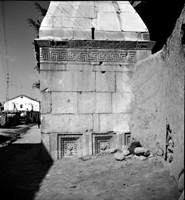 MAMA XI 197 (Synnada)
MAMA XI 197 (Synnada) 
Various Roman and Byzantine architectural elements
- Type of monument:
- Various architectural elements.
- Location:
- Şuhut (Synnada): in the base of the minaret of Ulu Cami.
- Description:
- (1) Two fragments of tenth- or eleventh-century chancel barrier lintels. (2) Two frieze blocks of the Roman imperial period with single maeander pattern and reverse cyma mouldings above and below. (3) Single large block from a coffered ceiling of the Roman imperial period, with three coffers, each with a five-pointed star or flower in the centre, surrounded by a square border of egg-and-dart decoration, and two bead-and-reel mouldings. Between the coffers, soffits with guilloche decoration.
- Dimensions:
-
Not recorded.
- Record:
- Photograph (MHB negative 4534); line drawing; MB notebook copy (1955/29).
- Publication:
- None.
- Date:
- Various.
-
-
 MAMA XI 197 (Synnada)
MAMA XI 197 (Synnada) 




The base of the minaret of the Ulu Cami at Şuhut (date unknown) appears to have been constructed from a variety of ancient and mediaeval architectural members. For the tenth- or eleventh-century barrier lintels, compare MAMA XI 190 (1955/10), 191 (1955/18), 194 (1955/26), 195 (1955/27). For the use of maeander patterns in various architectural contexts in western Asia Minor in the early Roman imperial period, see Pülz 1989: 20-1; Vandeput 1997: 74-5. A maeander-frieze is also found as part of the outer decoration of the main portal to the mid-thirteenth century Ak Han near Denizli; maeander-patterns are otherwise unknown in Seljuq architectural decoration, and this frieze too is likely to have been re-used from a building of the Roman imperial period at Laodikeia (Erdmann 1961: 67-72, with Abb. 96-7).